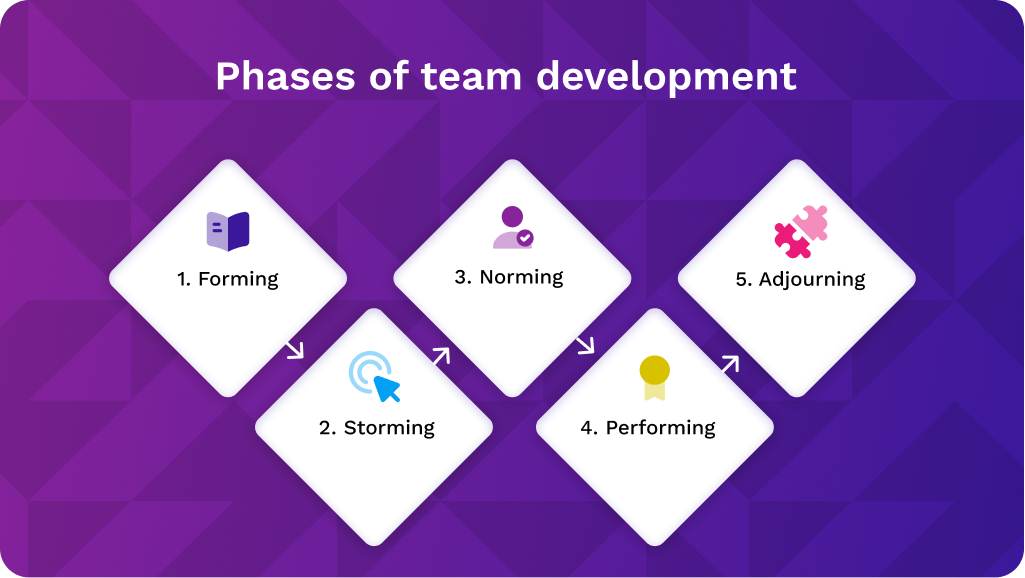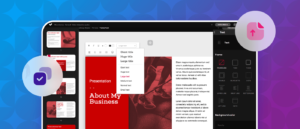Table of contents
ToggleTeamwork is one of the vital elements regarding the organization´s efficiency, it involves several people working together for a common goal, seeking benefits for the company. This method of collaboration allows to create synergies, increase proactivity, horizontal structures, and stimulate interpersonal relations….it is full of advantages!
But just like any mechanism, a team needs time to maximize productivity, since it involves going through various phases before even working in a cohesive way. This trajectory is divided in several phases, it is known as team development.
¿What exactly is team development? In this post we will go through the different steps associated with development and the impact that leaders have regarding group work.
What is team development?
Team development focuses on supporting and training employees to increase the impact of their work. When team members feel comfortable around each other, it makes it easier for them to collaborate. Otherwise, if there are cooperation issues, it will take more time for them to finish tasks.
Bruce Tuckman, an American psychologist, was the first to conceive this concept and record the different phases that compose development within teams. His investigations found in his essay ¨Developmental sequence in small groups¨, analyzed how groups formed by people who do not know each other go through various steps before becoming an efficient work group.
Phases of the development of teams
Tuckman established a 5-stage model: forming, storming, norming, performing and adjourning.
Stage 1: Forming – setting the base for success
The initial stage of a team is forming. Team members hardly know each other and do not feel secure when interacting with each other. During this phase, the productivity of the group is low. Each person is still adapting and discovering their role within the team.
Stage 2: Storming – Learning to work as a team
At this point, members of the team learn how to work together. Since the role of each member is not defined interpersonal conflicts will arise since each person is struggling to find the right role for themselves.
The different personalities and the way each one perceive the development of the project may cause frictions within the team.
Stage 3: Norming – Developing group cohesion
When the team members find their rhythm, everything starts to flow and stability kicks in. The employees feel comfortable working together: asking for help with a task, receiving constructive feedback etc.
Thus, the productivity of the group increases in this stage, as the team becomes more familiar with each other and their ways of working. The team – as a whole- becomes more efficient.
Stage 4: Performing – Reaching the full potential
At this point, the group already feels united and all the people in it work together to achieve a common goal, reaching their full potential. The team follows the established workflows with total fluidity. This phase is the pinnacle of team development, so the leaders’ goal must be to reach it as quickly as possible.
Stage 5: Dissolution of the team
Known as the mourning stage, as it is the final phase of a team, when a project ends or the group dissolves. In fact, it is natural for the members of the group to have difficulty working with other teams, having achieved a strong group dynamic.
In this final phase, good leaders take the opportunity to congratulate the team on its performance, praising the achievements of each member of the group.
How to guide your team in each stage: practical tips
When you create a new working group it is important to take into consideration the five development stages. This will help each member achieve their highest potential within the team. Although there is no single formula for achieving cohesion in a work group, there are dynamics that help to achieve it.
Do not avoid conflicts
Allowing group collaboration during the forming stage can help reduce, or even avoid, the appearance of conflicts. Nevertheless, this does not mean that it will not happen. In fact, disagreements are actually important to stimulate a positive group collaboration.
When conflicts emerge, resolving rather than avoiding them, is far more interesting. If members of the team already have collaborative skills, these conflicts are quickly and easily resolved.
Addressing conflicts assertively
Conflict resolution is a valuable method to create an honest and unbiased workplace.
The leader will be the one to establish the internal standards to resolve any team conflict. Ultimately, a group that works together to solve problems will enjoy greater mutual trust.
Establish team objectives
Before starting to collaborate, it is important to establish a common objective. This will ensure that everyone is going in the same direction in pursuit of the same goal. It is also important to provide each member with a specific role to establish a clearly defined assignment of tasks from the outset.
Define a communication plan
Creating a communication plan will let team members know how to transfer information to the rest of the members. Efficient communication plans allow employees to understand their daily tasks, work properly and have access to any type of information.
With a clearly established communication plan the team will have the tools necessary to address problems with their peers in a constructive way.
Reinforce the strengths of each team member
The group leader must assign responsibilities and establish roles according to the strengths of each member. Reinforcing individual abilities of each one will improve teamwork, as each has a specific function.
Leadership in team development: keys to success
A good leader is the fundamental basis of a high-performing team. Without a solid leadership, employees will find it hard to perform. So, what essential skills should a leader have?
- Communication skills. A good leader should know how to communicate effectively. Active listening is just as important as speaking.
- Empathy. To manage communication with each member in personalized and assertive way.
- Emotional intelligence. The capacity to motivate each employee and correctly manage the internal relationships of the team.
- Critical thinking. Analyze and evaluate each process to make decisions that will help achieve the established objective.
- Coordinate. Manage times efficiently and align efforts of each member in the same direction.
- Motivate and inspire. A good leader needs to inspire and motivate their staff to increase performance by working comfortably.
Tools for team development
The proper functioning of a team does not depend solely on an efficient and assertive leader. Currently, selecting the right tools to work with is fundamental for a team to work properly. Which ones should be considered?
Tools to generate ideas, lists and mental maps
One of the great strengths of teamwork, are dynamic group activities such as brainstorming. Group brainstorming usually leads to great plans, very useful for the improvement of a company or a project.
Platforms such as Todoist or MindMeister let you collect ideas generated by the group in an orderly, hierarchical, and visual way. You can make lists and stimulate your team’s creativity. Besides these two, there are all kinds of platforms, so you will need choose the one that best adapts to your team’s needs.
Time management tools
These tools are great to optimize processes within the team and monitor the time invested in each task. They are a fundamental support for leaders to check the effort it takes for the group to complete each task. Software such as Rescue Time Teams or Sesame Time have features to manage teams by project and tasks to increase productivity.
Cloud-based tools
They are the software related to data security at work, they allow remote meetings or file storage. Though there are thousands of programs, each with different functionalities and purposes, their main objective is to improve the productivity of the company and the team.
Some examples include Microsoft Teams, which allows all team members to group together in different chats, virtual rooms and meetings; or Google Drive, a tool for storing files, sharing documents and creating workspaces.
Employee management tools and corporate culture
They help to categorize the productivity of each member, understand the behavior of each one, recruit new employees and improve the work culture of a company.
Software such as ActivTrak helps to analyze employee behavior, providing data to improve processes based on objective data.
Tools to promote team training
One of the most important factors for an employee to feel valued is to encourage their training. This will allow them to grow within the company and be able to aspire to new challenges, stimulating their motivation.
But training the team is not enough. Providing employees with valuable courses that are agile, enjoyable and that stimulate their learning curve is just as important.
It is just as important to facilitate their training as it is to provide them with valuable, agile, and enjoyable courses to stimulate their learning.
Moreover, in recent times, the development of soft skills has shown to be one the most important elements for teamwork and business success. Additionally, it is important to have a complete catalog of courses that responds to the needs of all types of profiles, to promote upskilling of each member.
Stimulate your team’s training with isEazy Skills
Course catalogs such as those offered by isEazy Skills enable the promotion of all employees, covering any need, profile, or position. These agile, interactive, and accessible trainings will captivate employees through dynamic and enjoyable learning experiences. With its 100% practical methodology, you will be able to upskill or reskill teams in their day-to-day work.
What are you waiting for to get to know isEazy Skills? Take a look at one of our courses!















